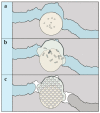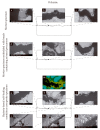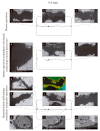A Bacteria-Based Self-Healing Cementitious Composite for Application in Low-Temperature Marine Environments
- PMID: 31105176
- PMCID: PMC6352682
- DOI: 10.3390/biomimetics2030013
A Bacteria-Based Self-Healing Cementitious Composite for Application in Low-Temperature Marine Environments
Abstract
The current paper presents a bacteria-based self-healing cementitious composite for application in low-temperature marine environments. The composite was tested for its crack-healing capacity through crack water permeability measurements, and strength development through compression testing. The composite displayed an excellent crack-healing capacity, reducing the permeability of cracks 0.4 mm wide by 95%, and cracks 0.6 mm wide by 93% following 56 days of submersion in artificial seawater at 8 °C. Healing of the cracks was attributed to autogenous precipitation, autonomous bead swelling, magnesium-based mineral precipitation, and bacteria-induced calcium-based mineral precipitation in and on the surface of the bacteria-based beads. Mortar specimens incorporated with beads did, however, exhibit lower compressive strengths than plain mortar specimens. This study is the first to present a bacteria-based self-healing cementitious composite for application in low-temperature marine environments, while the formation of a bacteria-actuated organic⁻inorganic composite healing material represents an exciting avenue for self-healing concrete research.
Keywords: bacteria-actuated; low-temperature; marine; organic–inorganic composite; self-healing concrete.
Conflict of interest statement
The authors declare no conflicts of interest.
Figures








References
-
- Guimard N.K., Oehlenschlaeger K.K., Zhou J., Hilf S., Schmidt F.G., Barner-Kowollik C. Current trends in the field of self-healing materials. Macromol. Chem. Phys. 2012;213:131–143. doi: 10.1002/macp.201100442. - DOI
-
- Van Breugel K. Is there a market for self-healing cement-based materials; Proceedings of the First International Conference on Self-Healing Materials; Noordwijk aan Zee, The Netherlands. 18–20 April 2007.
-
- Jonkers H.M. Self Healing Materials. Springer; Doordercht, The Netherlands: 2008. Self healing concrete: A biological approach; pp. 195–204.
-
- Jonkers H.M., Thijssen A., Muyzer G., Copuroglu O., Schlangen E. Application of bacteria as self-healing agent for the development of sustainable concrete. Ecol. Eng. 2010;36:230–235. doi: 10.1016/j.ecoleng.2008.12.036. - DOI
Grants and funding
LinkOut - more resources
Full Text Sources
Other Literature Sources

